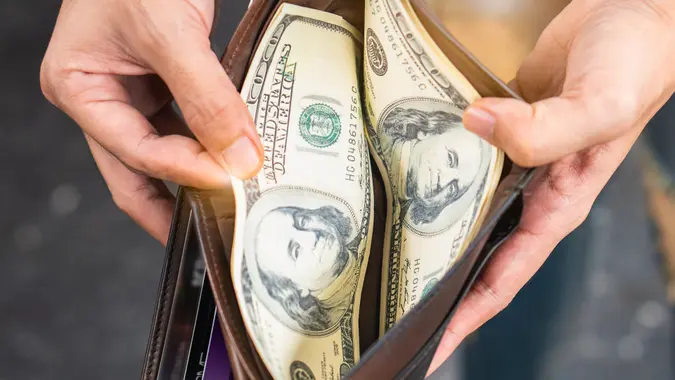Advertiser Disclosure
GOBankingRates works with many financial advertisers to showcase their products and services to our audiences. These brands compensate us to advertise their products in ads across our site. This compensation may impact how and where products appear on this site. We are not a comparison-tool and these offers do not represent all available deposit, investment, loan or credit products.
21 Disposable Products You Should Reuse To Save Money, According to Personal Finance YouTuber Tae Kim
 Written by
Nicole Symon
Written by
Nicole Symon
 Edited by
Rebekah Evans
Edited by
Rebekah Evans

Commitment to Our Readers
GOBankingRates' editorial team is committed to bringing you unbiased reviews and information. We use data-driven methodologies to evaluate financial products and services - our reviews and ratings are not influenced by advertisers. You can read more about our editorial guidelines and our products and services review methodology.

20 YearsHelping You Live Richer

Reviewed by Experts

Trusted by Millions of Readers
Disposable products are convenient and often appear cheap at first glance, but these costs can add up quickly. If you reuse them instead of throwing them out after the first use, you get much more out of your purchase. You’ll save money and reduce your waste.
In a YouTube video, personal finance influencer Tae Kim listed 21 items that people typically consider disposable but can actually be used multiple times. To be more frugal, try implementing some of his ideas.
Birthday Candles
A delicious cake decorated with candles is a great way to celebrate a loved one’s birthday. After the guest of honor blows out the candles, clean them off and put them away to use again on the next special occasion.
Although a box of basic candles generally costs only a few dollars or less, specialty candles, including numbers or letters, can be more expensive. Why purchase new candles for each occasion when you can easily reuse the ones you already have?
“I used the same candle for my kids’ birthday cake for the past 10 years and they have never noticed,” Kim said.
Gift Bags
You can also use gift bags a second time. If someone gives you a gift in a beautiful gift bag, don’t throw that bag out. It’s part of the gift and you can give it a second life.
Store your gift bags with your other gift-giving supplies for the next time you give someone a present. Gift bags typically cost between $1 and $5 but can be over $20 for large decorative ones. Each time you reuse a gift bag, you reduce your waste and save at least a few dollars.
The recipient of your reused gift bag will never know the difference. Just make sure you tear off any tags or personalized touches before passing on the bag.
Kim confessed that he has “a collection of gift bags of all sizes and all occasions.”
“Who says you can’t use a Christmas-themed gift bag for a birthday present if it’s the perfect size?” he asked. “I have no shame.”
Gift-Wrapping Supplies
Along the same lines, Kim recommended reusing gift-wrapping supplies. He suggested keeping nice tissue paper from gift bags, ribbons, gift boxes and sometimes even the wrapping paper itself when someone gives you a gift.
If these items are still in good condition and you have room to store them somewhere, consider keeping them for the next time you give a gift. Buying all of the supplies you need to wrap a present can be more expensive than you may realize.
Use these costs as examples:
- Gift box: $5 to $10 for small to midsize boxes
- Wrapping paper: $5 to $10 per roll
- Tissue paper: around $2 for six sheets
- Bow: $2 to $3 for large bows
- Ribbon: $3 to $4 per roll
Wrapping a single present could cost $10 or more, depending on your chosen supplies. Depending on how many special occasions you attend, that could total more than $100 over a whole year of gift-giving.
Free Hotel Products
One of the best parts of staying in a hotel is seeing all the “free” products that come with your room. Hotels often provide soap, shampoo, conditioner, lotion and other toiletries. As Kim pointed out, higher-end hotels typically offer even higher-quality versions of these products. They’re not really free since they’re included in the booking cost, but they’re fun nonetheless.
You don’t have to throw these items away or leave them when you check out. If there’s any product left over, consider taking it with you to use at home. Save these products and use them as needed. Since a single travel-size bottle of shampoo or conditioner can cost between $2 and $4, taking the free hotel products is worth the room in your suitcase.
“We have a whole bin dedicated to free hotel stuff we’ve collected,” Kim said. “I can’t remember the last time I had to buy a bar of soap because I have so many stacked in our bin.”
Scratch Paper
Even in the digital age, sometimes you just need to jot something down. Instead of reaching for a new piece of paper each time and throwing it out afterward, try reusing stray paper as scratch paper.
If you write in small print, you can repeatedly use the same piece of paper. Make sure to use both sides whenever possible. You can reuse printouts you no longer need, as well as junk mail and random papers from work or school.
Kim said this advice is particularly useful for families with children: “I have a bin where I throw all the paper that can be potentially reused and this comes in especially handy when my kids ask for paper to do stuff on for crafts, for drawing or just to doodle.”
A ream of plain copy paper costs around $10, so if you use paper often, these savings will add up.
Folders
You probably have many file folders if you work in an office. Even for personal organization or your children’s schooling, you may have several folders lying around.
It’s tempting to throw these folders out after a single use. However, there’s no reason not to reuse them unless they’re badly damaged. Kim recommended giving them a second life “as a folder for your kids’ artwork or unprocessed bills.” If you wrote a label on the folder, you can cover it with a new one using a Post-it note or label maker so you don’t get confused.
A box of 100 file folders costs around $20 or 20 cents each. Every time you reuse one of these folders, you’re saving 20 cents.
Newspapers
In recent years, physical newspapers have become much less popular, according to Pew Research Center. However, if you still get an actual newspaper in the mail, there are many ways to reuse it once you’re done reading it.
Kim suggested using the newspaper to protect your floor while painting, to help start a fire in your barbecue or to protect items you’re packaging for shipping: “I use old newspapers to fill in the cracks inside the box. Not only are they just as effective in protecting the package I’m shipping; I don’t need to spend precious dollars [on something] that would have ended up in the box anyway.”
If you had to buy packing peanuts instead of using old newspapers, that would cost around $15 for five cubic feet. Similarly, a package of plastic drop cloth, to protect your floors while painting, is around $10 per package. You can find many creative ways to reuse old newspapers so you don’t have to spend money on these products.
Blank Letter Envelopes
Sometimes, you still need to send snail mail and in those cases, you’ll also need envelopes. Don’t throw out the blank envelopes you get. Instead, collect them and set them aside to use later. They don’t take up much space, so finding a place to keep them should be easy.
“You can find extra envelopes inside mail companies send to make it easier to pay your bills,” Kim said. “If a company happens to send you free blank letter envelopes, save them for future use.”
A box of 100 business envelopes is around $10. If you keep and reuse all the blank letter envelopes you get, you could save a few dollars each year.
Takeout Containers
Between meal delivery services and traditional takeout, you probably get plenty of takeout containers. Many people just eat their food and throw these containers away. A better option is to clean them and keep them for the next time you need to store food.
An extensive set of food storage containers can cost $30 or more. Instead, save your money and reuse your takeout containers. Sure, your containers probably won’t all match, but the money you’ll save is worth it.
Kim even recommended using takeout containers to store things other than food: “What I like to do is use them to store loose items, especially loose kids’ items. These clear ones are great — I can see what’s in them and if they crack or break, I’m not annoyed because I got them for free anyway.”
Toothbrushes
The American Dental Association recommends replacing your toothbrush at least every three to four months. Don’t just throw your old toothbrush in the trash when that time is up, though. There are other ways to use an old toothbrush besides cleaning your teeth.
Specifically, Kim recommended using old toothbrushes to clean things around the house: “Small-head toothbrushes are great for reaching into small spaces where larger brushes can’t reach. I especially like using them to clean bathroom and kitchen grout.”
Before reusing your toothbrush as a cleaning tool, make sure to disinfect it. Boil just the bristles for a few minutes while keeping the plastic handle out of the hot water. Then, it should be ready for all of your cleaning needs.
Designated small cleaning brushes cost around $10 for a set, so reusing your toothbrushes can reduce your cleaning supply costs quite a bit.
Aluminum Foil
Kim also recommended using aluminum foil more than once. As long as you’re careful not to tear it, you can wash used aluminum foil with soap and water. Then, leave it to dry, and soon it will be ready to use again. You can fold it and keep it near your other food storage supplies.
A box of standard aluminum foil is over $3. The more you reuse the foil you already have, the more you’ll save.
Glass Containers
While many products come in plastic, you probably buy some items in glass containers. Examples include pickle jars, jam jars and drink bottles. Once you finish the original products, wash out the glass containers and reuse them as storage.
Kim likes to reuse glass containers to store small loose items outside the kitchen. You can also use them for kitchen storage, though. He gives the example of pouring oil into an extra glass jar to have it available while cooking.
By reusing glass containers from products you’re already buying, you may not need to buy designated storage containers. A large set of glass containers costs around $50, so those are some significant savings.
Amazon Cardboard Boxes
Amazon delivers more than 16 million packages daily, many of which come in cardboard boxes. If your Amazon packages are in boxes, don’t throw them away. Instead, keep them in case you need to ship or store anything in a cardboard box later.
Large boxes could take up a lot of space in your home, so break them down by cutting all of the tape. Once they’re flat, the boxes are much easier to store.
Kim said he uses his old Amazon boxes whenever he needs to mail or return purchased products: “These boxes come in very handy. No need to ever pay money for boxes.”
If you have to buy boxes, they cost around $1.50 each for basic, small-sized options. Larger boxes are more expensive. Why waste money buying new boxes when you can reuse your Amazon boxes for free?
Packing Material
Similarly, you should keep and reuse the packing material that arrives in the box when you order products. These might be Styrofoam fillers, bubble wrap or air pillows made of plastic.
As Kim said, “Companies are sending them to you for free, so no need to ever buy them if you can help it.”
A package of air pillows costs around $17.50 and foam wrap rolls cost over $12. Save your money and keep the packing material you get with your orders.
Apple Product Boxes
Apple famously uses high-quality boxes to package all of its products. Kim mentioned that they’re quite sturdy, well-built and aesthetically pleasing. It seems like a waste to just throw them away every time you buy an Apple product.
Instead, Kim suggested using them to organize small items in your home, like as a drawer organizer. Drawer organizers can cost over $20, so reusing your Apple boxes is a great way to reduce your waste and save money.
Rubber Bands
Rubber bands are surprisingly useful around the house. Many products, including vegetables like broccoli and asparagus, come with them for free. Take them off those items and store them in a separate container. As Kim said, “There’s no need to throw them away just because they’ve been used once.”
If you save them, the next time you need to secure something with a rubber band, you’ll have a collection to choose from. You won’t need to spend the $10 a bag of rubber bands costs.
Twist Ties
Twist ties are similar. Many companies use them to secure their items, so you get them for free with your purchase.
Save your twist ties to reuse them later so you won’t have to buy a $10 box. Kim suggested using them to tie together cables or secure a bag of cookies.
Plastic Easter Eggs
Celebrating Easter with an egg hunt is always good fun. Many people now use plastic Easter eggs to hide small candies or treats for their kids to find. When the Easter egg hunt is over, save the empty eggs for next year’s celebration. As long as they’re not cracked or damaged, you can reuse them year after year.
A bulk package of plastic eggs costs over $20, so you can save $20 each year by reusing your plastic eggs. Kim said he reuses his Easter eggs every year and his kids don’t know the difference.
Free Crayons From Restaurants
Family restaurants often give kids free crayons and something to doodle on while they’re waiting for their food. You can take these crayons with you when you leave to continue the fun at home. You’ll save a dollar by not having to buy crayons from the store.
The Previous Year’s Calendar
When the clock strikes midnight on New Year’s Eve, you may think it’s time to throw out last year’s calendar. Kim argued that you can reuse it to cover the table when the kids do arts and crafts. A roll of plastic table covering costs around $30, which you can save by reusing your calendars instead.
Used Coffee Grounds
After making your morning coffee, you probably throw out the used coffee grounds. You can actually get more use out of those grounds, though — and not by making more coffee with them.
Kim and his wife found ways to reuse their grounds since they drink so much coffee. They use them in the garden as fertilizer, which can cost $15 per bag otherwise. You can also use the grounds to neutralize odors in your home.
More From GOBankingRates
- Nearly 1 in 3 Americans Hit by a Costly Holiday Scam, Norton Survey Shows -- How To Avoid This
- Here's What Retirees Wasted the Most Money On in 2025 -- and How To Avoid It in 2026
- How Middle-Class Earners Are Quietly Becoming Millionaires -- and How You Can, Too
- 6 Safe Accounts Proven to Grow Your Money Up to 13x Faster
Share This Article:




Make your money work for you
Get the latest news on investing, money, and more with our free newsletter.
By subscribing, you agree to our Terms of Use and Privacy Policy. Unsubscribe at any time.


Thanks!
You're now subscribed to our newsletter.
Check your inbox for more details.



Sending you timely financial stories that you can bank on.
Sign up for our daily newsletter for the latest financial news and trending topics.
For our full Privacy Policy, click here.
Looks like you're using an adblocker
Please disable your adblocker to enjoy the optimal web experience and access the quality content you appreciate from GOBankingRates.
- AdBlock / uBlock / Brave
- Click the ad blocker extension icon to the right of the address bar
- Disable on this site
- Refresh the page
- Firefox / Edge / DuckDuckGo
- Click on the icon to the left of the address bar
- Disable Tracking Protection
- Refresh the page
- Ghostery
- Click the blue ghost icon to the right of the address bar
- Disable Ad-Blocking, Anti-Tracking, and Never-Consent
- Refresh the page

















